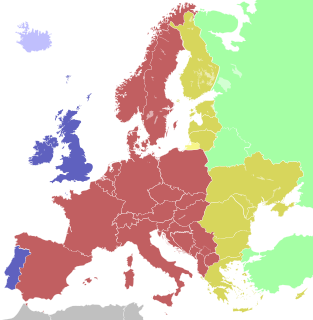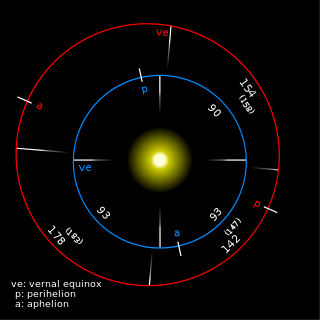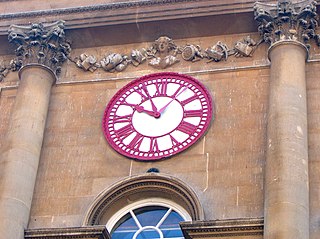Related Research Articles
The word day has a number of meanings, depending on the context it is used such as of astronomy, physics, and various calendar systems.

Greenwich Mean Time (GMT) is the mean solar time at the Royal Observatory in Greenwich, London, counted from midnight. At different times in the past, it has been calculated in different ways, including being calculated from noon; as a consequence, it cannot be used to specify a particular time unless a context is given. The term 'GMT' is also used as one of the names for the time zone UTC+00:00 and, in UK law, is the basis for civil time in the United Kingdom.

A time zone is an area that observes a uniform standard time for legal, commercial and social purposes. Time zones tend to follow the boundaries between countries and their subdivisions instead of strictly following longitude, because it is convenient for areas in frequent communication to keep the same time.
A time standard is a specification for measuring time: either the rate at which time passes or points in time or both. In modern times, several time specifications have been officially recognized as standards, where formerly they were matters of custom and practice. An example of a kind of time standard can be a time scale, specifying a method for measuring divisions of time. A standard for civil time can specify both time intervals and time-of-day.
Universal Time (UT) is a time standard based on Earth's rotation. There are several versions of Universal Time, which differ by up to a few seconds. The most commonly used are Coordinated Universal Time (UTC) and UT1. All of these versions of UT, except for UTC, are based on Earth's rotation relative to distant celestial objects, but with a scaling factor and other adjustments to make them closer to solar time. UTC is based on International Atomic Time, with leap seconds added to keep it within 0.9 second of UT1.

Swatch Internet Time is a decimal time concept introduced in 1998 by the Swatch corporation as part of their marketing campaign for their line of "Beat" watches.

The Alaska Time Zone observes standard time by subtracting nine hours from Coordinated Universal Time (UTC−09:00). During daylight saving time its time offset is eight hours (UTC−08:00). The clock time in this zone is based on mean solar time at the 135th meridian west of the Greenwich Observatory.

Time in the United States, by law, is divided into nine standard time zones covering the states, territories and other US possessions, with most of the United States observing daylight saving time (DST) for approximately the spring, summer, and fall months. The time zone boundaries and DST observance are regulated by the Department of Transportation. Official and highly precise timekeeping services (clocks) are provided by two federal agencies: the National Institute of Standards and Technology (NIST) ; and the United States Naval Observatory (USNO). The clocks run by these services are kept synchronized with each other as well as with those of other international timekeeping organizations.

Standard time is the synchronisation of clocks within a geographical region to a single time standard, rather than a local mean time standard. Generally, standard time agrees with the local mean time at some meridian that passes through the region, often near the centre of the region. Historically, standard time was established during the 19th century to aid weather forecasting and train travel. Applied globally in the 20th century, the geographical regions became time zones. The standard time in each time zone has come to be defined as an offset from Universal Time. A further offset is applied for part of the year in regions with daylight saving time.

Local mean time is a form of solar time that corrects the variations of local apparent time, forming a uniform time scale at a specific longitude. This measurement of time was used for everyday use during the 19th century before time zones were introduced beginning in the late 19th century; it still has some uses in astronomy and navigation.

Though no standard exists, numerous calendars and other timekeeping approaches have been proposed for the planet Mars. The most commonly seen in the scientific literature denotes the time of year as the number of degrees from the northern vernal equinox, and increasingly there is use of numbering the Martian years beginning at the equinox that occurred April 11, 1955.
Nepal Standard Time (NPT) is the time zone for Nepal. With a time offset from Coordinated Universal Time (UTC) of UTC+05:45 all over Nepal, it is one of only three time zones with a 45-minute offset from UTC.

South African Standard Time (SAST) is the time zone used by all of South Africa as well as Eswatini and Lesotho. The zone is two hours ahead of UTC (UTC+02:00) and is the same as Central Africa Time. Daylight saving time is not observed in either time zone. Solar noon in this time zone occurs at 30° E in SAST, effectively making Pietermaritzburg at the correct solar noon point, with Johannesburg and Pretoria slightly west at 28° E and Durban slightly east at 31° E. Thus, most of South Africa's population experience true solar noon at approximately 12:00 daily.
The time in China follows a single standard time offset of UTC+08:00, even though China spans almost five geographical time zones. The official national standard time is called Beijing Time domestically and China Standard Time (CST) internationally. Daylight saving time has not been observed since 1991.
Thailand follows UTC+07:00, which is 7 hours ahead of UTC. The local mean time in Bangkok was originally UTC+06:42:04. Thailand used this local mean time until 1920, when it changed to Indochina Time, UTC+07:00; ICT is used all year round as Thailand does not observe daylight saving time. Thailand shares the same time zone with Vietnam, Cambodia, Laos, Christmas Island, and Western Indonesia.

In Norway the standard time is the Central European Time (CET). Norway observes Summer Time. The transition dates are the same as for other European countries.

Railway time was the standardised time arrangement first applied by the Great Western Railway in England in November 1840, the first recorded occasion when different local mean times were synchronised and a single standard time applied. The key goals behind introducing railway time were to overcome the confusion caused by having non-uniform local times in each town and station stop along the expanding railway network and to reduce the incidence of accidents and near misses, which were becoming more frequent as the number of train journeys increased.

Coordinated Universal Time or UTC is the primary time standard by which the world regulates clocks and time. It is within about 1 second of mean solar time at 0° longitude such as UT1 and is not adjusted for daylight saving time. It is effectively a successor to Greenwich Mean Time (GMT).

Spain has two time zones and observes daylight saving time. Spain mainly uses Central European Time (GMT+01:00) and Central European Summer Time (GMT+02:00) in Peninsular Spain, the Balearic Islands, Ceuta, Melilla and plazas de soberanía. In the Canary Islands, the time zone is Western European Time (GMT±00:00) and Western European Summer Time (GMT+01:00). Daylight saving time is observed from the last Sunday in March to the last Sunday in October throughout Spain.
Oxford time is the custom of having scheduled events occur five minutes past the specified time. It is a peculiar tradition of timekeeping in Oxford, especially in connection with the University of Oxford.
References
- ↑ Oxford English Dictionary. Oxford University Press.